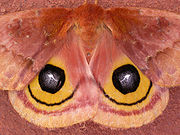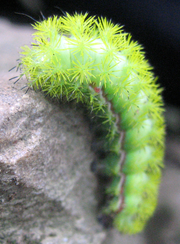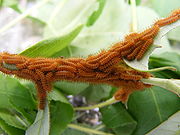
Automeris io
Encyclopedia
The Io Moth is a very colorful North American moth
in the Saturniidae
family. It ranges from the southeast corner of Manitoba and in the southern extremes of Ontario, Quebec, and New Brunswick in Canada, and in the US it is found from Montana, North Dakota, South Dakota, Nebraska, Colorado, New Mexico, Texas, Utah, east of those states and down to the southern end of Florida.
have a wingspan of 2.5-3.5 inches. This species is sexually dimorphic
, males having bright yellow forewings, body, and legs, while females have reddish brown forewings, body, and legs. The males also have much bigger plumose (feathery) antennae
than the females. Both have one big black to bluish eyespot
with some white in the center, on each hindwing, a defense mechanism meant to frighten off potential predators.

 Females lay small, white ova in the leaves of host
Females lay small, white ova in the leaves of host
plants, including, but not limited to:
The eggs have large micropyle
rosettes that turn black as the fertile eggs develop. They are usually laid in clusters of more than twenty. From the eggs, orange larva
e emerge, usually eating their egg shell soon after hatching. They go through 5 instar
s, each one being a little different.
The caterpillars are gregarious in all their instars, many times traveling in single file processions all over the food plant. As the larvae develop, they will lose their orange color and will turn bright green and urticating
, having many spines. These stinging spines have a very painful venom
that is released with the slightest touch. The green caterpillars have two lateral stripes, the upper one being bright red and the lower one being white. When the caterpillars are ready, they spin a flimsy, valveless cocoon made from a dark, coarse silk
. Some larvae will crawl to the base of the tree and make their cocoons amongst leaf litter on the ground, while others will use living leaves to wrap their cocoons with. The leaves will turn brown and fall to the ground during autumn, taking the cocoons with them. There they pupa
te, the pupa being dark brown/black. The pupae of the females are considerably larger than those of the males.
Adult moths emerge from their cocoons in late morning or early afternoon. Eclosion (emergence from the cocoon) only takes a few minutes. After eclosing, the moths climb and hang on plants so that their furled wings can be inflated with fluid (hemolymph
) pumped from the body. This inflation process takes about twenty minutes.
Adult moths are strictly nocturnal, flying generally only during the first few hours of the night (Fullard & Napoleone 2001). The females generally wait until nightfall and then extend a scent gland
from the posterior region of the abdomen
, in order attract males via wind-borne pheromone
s. The males use their much bigger antennae to track down the females. After mating, the females lay eggs then wait to die. These moths, like all moths in the Saturniidae family, have vestigial
mouthparts and do not eat in the adult form.

Moth
A moth is an insect closely related to the butterfly, both being of the order Lepidoptera. Moths form the majority of this order; there are thought to be 150,000 to 250,000 different species of moth , with thousands of species yet to be described...
in the Saturniidae
Saturniidae
The Saturniidae, commonly known as saturniids, are among the largest and most spectacular of the moths. They form a family of Lepidoptera, with an estimated 1,300 to 1,500 described species worldwide...
family. It ranges from the southeast corner of Manitoba and in the southern extremes of Ontario, Quebec, and New Brunswick in Canada, and in the US it is found from Montana, North Dakota, South Dakota, Nebraska, Colorado, New Mexico, Texas, Utah, east of those states and down to the southern end of Florida.
Adult description
ImaginesImago
In biology, the imago is the last stage of development of an insect, after the last ecdysis of an incomplete metamorphosis, or after emergence from the pupa where the metamorphosis is complete...
have a wingspan of 2.5-3.5 inches. This species is sexually dimorphic
Sexual dimorphism
Sexual dimorphism is a phenotypic difference between males and females of the same species. Examples of such differences include differences in morphology, ornamentation, and behavior.-Examples:-Ornamentation / coloration:...
, males having bright yellow forewings, body, and legs, while females have reddish brown forewings, body, and legs. The males also have much bigger plumose (feathery) antennae
Antenna (biology)
Antennae in biology have historically been paired appendages used for sensing in arthropods. More recently, the term has also been applied to cilium structures present in most cell types of eukaryotes....
than the females. Both have one big black to bluish eyespot
Eyespot (mimicry)
An eyespot is an eye-like marking. They are found on butterflies, reptiles, birds and fish. In members of the Felidae family , the white circular markings on the backs of the ears are termed ocelli, and they are functionally similar to eyespots in other animals.Eyespots may be a form of...
with some white in the center, on each hindwing, a defense mechanism meant to frighten off potential predators.
Life cycle


Host (biology)
In biology, a host is an organism that harbors a parasite, or a mutual or commensal symbiont, typically providing nourishment and shelter. In botany, a host plant is one that supplies food resources and substrate for certain insects or other fauna...
plants, including, but not limited to:
- Prunus pensylvanica — Pin cherry
- Salix — Willow
- Abies balsamea — Balsam fir
- Acer rubrum — Red maple
- Amorpha fruticosaAmorpha fruticosaAmorpha fruticosa is a species of flowering plant in the legume family known by several common names, including desert false indigo and bastard indigobush. It is found throughout eastern Canada, northern Mexico, and most of the continental United States, but it is probably naturalized in western...
— Bastard indigo - Baptisia tinctoriaBaptisia tinctoriaBaptisia tinctoria is a herbaceous perennial plant in the family Fabaceae. It is native to eastern North America.-Distribution:...
— Wild indigo - Carpinus caroliniana — American hornbeam
- Celtis laevigataCeltis laevigataCeltis laevigata is a medium-sized tree native to North America. Common names include Sugarberry, Southern Hackberry, or in the southern U.S. Sugar Hackberry or just Hackberry....
— Texas sugarberry - Cephalanthus occidentalisCephalanthus occidentalisCephalanthus occidentalis is a species of flowering plant in the coffee family, Rubiaceae, that is native to eastern and southern North America. Common names include Buttonbush, Common Buttonbush, Button-willow and Honey-bells....
- Button-bush - Cercis canadensis — Eastern Redbud
- Chamaecrista fasciculataChamaecrista fasciculataChamaecrista fasciculata is a species of legume native to most of the eastern United States. It is an annual which grows to approximately 0.5 meters tall...
— Showy Partridge Pea - Comptonia peregrina — Sweetfern
- Cornus florida — Flowering dogwood
- Corylus avellanaCorylus avellanaCorylus avellana, the Common Hazel, is a species of hazel native to Europe and western Asia, from the British Isles south to Iberia, Greece, Turkey and Cyprus, north to central Scandinavia, and east to the central Ural Mountains, the Caucasus, and northwestern Iran. It is an important component of...
— Common hazel - FagusBeechBeech is a genus of ten species of deciduous trees in the family Fagaceae, native to temperate Europe, Asia and North America.-Habit:...
— Beech - Fraxinus — Ash
- Liquidambar styraciflua - American Sweetgum
- Quercus - Oak
The eggs have large micropyle
Micropyle
A micropyle is small opening in the surface of an ovule, through which the pollen tube penetrates, often visible as a small pore in the ripe seed....
rosettes that turn black as the fertile eggs develop. They are usually laid in clusters of more than twenty. From the eggs, orange larva
Larva
A larva is a distinct juvenile form many animals undergo before metamorphosis into adults. Animals with indirect development such as insects, amphibians, or cnidarians typically have a larval phase of their life cycle...
e emerge, usually eating their egg shell soon after hatching. They go through 5 instar
Instar
An instar is a developmental stage of arthropods, such as insects, between each molt , until sexual maturity is reached. Arthropods must shed the exoskeleton in order to grow or assume a new form. Differences between instars can often be seen in altered body proportions, colors, patterns, or...
s, each one being a little different.
The caterpillars are gregarious in all their instars, many times traveling in single file processions all over the food plant. As the larvae develop, they will lose their orange color and will turn bright green and urticating
Urticating hair
Urticating hairs, i.e. stinging hairs, are one of the primary defense mechanisms used by numerous plants, some New World tarantulas, and various lepidopteran caterpillars. Urtica is Latin for "nettle", and hairs that urticate are characteristic of this type of plant, and many other plants in...
, having many spines. These stinging spines have a very painful venom
Venom
Venom is the general term referring to any variety of toxins used by certain types of animals that inject it into their victims by the means of a bite or a sting...
that is released with the slightest touch. The green caterpillars have two lateral stripes, the upper one being bright red and the lower one being white. When the caterpillars are ready, they spin a flimsy, valveless cocoon made from a dark, coarse silk
Silk
Silk is a natural protein fiber, some forms of which can be woven into textiles. The best-known type of silk is obtained from the cocoons of the larvae of the mulberry silkworm Bombyx mori reared in captivity...
. Some larvae will crawl to the base of the tree and make their cocoons amongst leaf litter on the ground, while others will use living leaves to wrap their cocoons with. The leaves will turn brown and fall to the ground during autumn, taking the cocoons with them. There they pupa
Pupa
A pupa is the life stage of some insects undergoing transformation. The pupal stage is found only in holometabolous insects, those that undergo a complete metamorphosis, going through four life stages; embryo, larva, pupa and imago...
te, the pupa being dark brown/black. The pupae of the females are considerably larger than those of the males.
Adult moths emerge from their cocoons in late morning or early afternoon. Eclosion (emergence from the cocoon) only takes a few minutes. After eclosing, the moths climb and hang on plants so that their furled wings can be inflated with fluid (hemolymph
Hemolymph
Hemolymph, or haemolymph, is a fluid in the circulatory system of some arthropods and is analogous to the fluids and cells making up both blood and interstitial fluid in vertebrates such as birds and mammals...
) pumped from the body. This inflation process takes about twenty minutes.
Adult moths are strictly nocturnal, flying generally only during the first few hours of the night (Fullard & Napoleone 2001). The females generally wait until nightfall and then extend a scent gland
Scent gland
Scent glands are found in the genital area of most mammals and in various other parts of the body, such as the underarms of humans and the preorbital glands of deer and muskox. They produce a semi-viscous fluid which contains pheromones. These odor-messengers indicate information such as status,...
from the posterior region of the abdomen
Abdomen
In vertebrates such as mammals the abdomen constitutes the part of the body between the thorax and pelvis. The region enclosed by the abdomen is termed the abdominal cavity...
, in order attract males via wind-borne pheromone
Pheromone
A pheromone is a secreted or excreted chemical factor that triggers a social response in members of the same species. Pheromones are chemicals capable of acting outside the body of the secreting individual to impact the behavior of the receiving individual...
s. The males use their much bigger antennae to track down the females. After mating, the females lay eggs then wait to die. These moths, like all moths in the Saturniidae family, have vestigial
Vestigial structure
Vestigiality describes homologous characters of organisms that have seemingly lost all or most of their original function in a species through evolution. These may take various forms such as anatomical structures, behaviors and biochemical pathways. Some of these disappear early in embryonic...
mouthparts and do not eat in the adult form.

External links
- Site with a description and pictures
- io moth on the UFUniversity of FloridaThe University of Florida is an American public land-grant, sea-grant, and space-grant research university located on a campus in Gainesville, Florida. The university traces its historical origins to 1853, and has operated continuously on its present Gainesville campus since September 1906...
/ IFASInstitute of Food and Agricultural SciencesThe University of Florida’s Institute of Food and Agricultural Sciences is a federal-state-county partnership dedicated to developing knowledge in agriculture, human and natural resources, and the life sciences, and enhancing and sustaining the quality of human life by making that information...
Featured Creatures Web site

